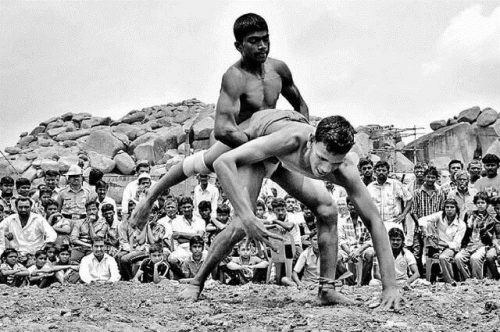A game, where in every 30 seconds there is a high point. It is a game of incredible fitness and unmatched intensity. Kabaddi , a short game in tune with today’s generation, has taken the Indian sports scenario to an unimaginable level that almost touched the famed height of cricket in India.
Kabaddi originated in rural India, some 4000 years ago. Even though there is no historical evidence as to when it really came into existence, there is a reference of Kabaddi in Mahabharata where Abhimanyu played a similar type of game. Indian history suggests that Gautam Buddha, as a young prince, often played Kabaddi to display his strength. Even, ancient Indian princes won their brides by displaying their skill in Kabaddi.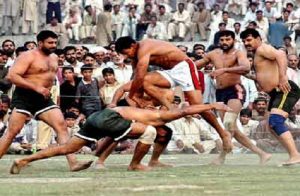
It is often deciphered that the game existed first in South India because of its closeness to a Tamil word ‘Kai-pidi’ meaning ‘to hold hands’. Along the same time, a similar type of game called Hu-Tu-Tu developed in the western part of India and Ha-Du-Du in the eastern areas. As it developed individually in different parts of India, different forms of Kabaddi evolved. This eventually gave rise to four types of forms – Sanjeevni Kabaddi, Gaminee Kabaddi, Amar Kabaddi and Punjabi Kabaddi. Modern Kabaddi is basically a synthesis of these different types of games.
Organizational Approach & Gradual Fading Away of Kabaddi
With Kabaddi being a part of our culture, the sport was extremely popular in the past. It was played anywhere and everywhere in India as the much needed natural turf was available abundantly during those times. It was a sport synonymous with skill, speed, strategic thinking, fitness, thrill and drama. The first known framework of the rules of Kabaddi was formulated in Maharashtra in the year 1921 on the pattern of Sanjeevani and Gemini in a combined form. Domestic competitions started to be played following this rule. As popularity increased, an organization was needed to bring uniformity in the game. So in 1950, the All India Kabaddi Federation was formed.
The first time Kabaddi received international recognition was when it was demonstrated as a sport at the 1936 Summer Olympics in Berlin. The first Asian Championships was held in 1980. The game was included in the South Asian Federation (SAF) Games from 1984 at Dhaka, Bangladesh. Kabaddi was included as a discipline at the 11th Asian Games Beijing in 1990 and India won the lone Gold Medal in Kabaddi. 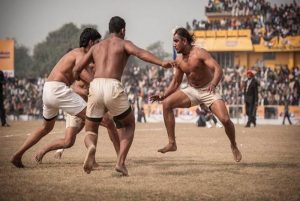 The dedication to the sport shown by Indian players is truly commendable. India created history by winning 5 consecutive Gold medals in the Asian Games. The women’s Kabaddi also got introduced in the 2010 Asian Games in Guangzhou. India even emerged champion in the first two World Cups. This truly proved that, though other countries played the game, but this indigenous sport still remained as one of the most original sports of India.
The dedication to the sport shown by Indian players is truly commendable. India created history by winning 5 consecutive Gold medals in the Asian Games. The women’s Kabaddi also got introduced in the 2010 Asian Games in Guangzhou. India even emerged champion in the first two World Cups. This truly proved that, though other countries played the game, but this indigenous sport still remained as one of the most original sports of India.
But the popularity of the game slowly faded away in the 1980s starting with India’s win in the cricket World Cup in 1983. The bat and ball game eclipsed all other sports. Cricket’s advent forced Kabaddi to take refuge in rural India. Coupled with this, the administrators also lacked futuristic approach. Domestic facilities did not match up to the expected standards. Though the players had much potential and performance, yet they struggled to keep their game alive.
What Kabaddi needed was a breath of fresh air. It was necessary to modernize the sport with role models and heroes. It was important to reach the drawing rooms of the people and have an audience across all sections of the society.
Revolutionary Approach Towards Kabaddi
It was in 2013 that Star India and Mashal Sports started to visualize a non-cricket league very close to the highly popular Indian Premier League. What struck to them was to target a sport that has a national culture and flavour. And then came the idea to introduce a Kabaddi league that is a homegrown, full contact sport with a history and forgotten legacy.
Star India believed in the fascinating and magical game of Kabaddi. The utter thrill of 40 minutes when lone players storming into the den of seven mighty opponents, tagging them and then running for their life as rivals try to pin them down, was enough to bring in the audience before television sets. The only necessity was to modernize the game.
Through Pro Kabaddi League, Star India redefined the game by some innovative set of rules, created a commercially-rewarding model for the players and the teams and generated a good television experience around the game. Players around the globe were screened and auctioned and teams representing eight Indian cities were born. 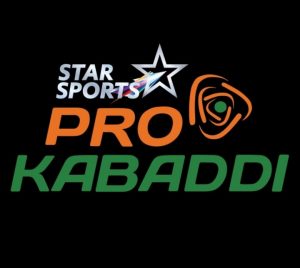 The initial eight teams were U Mumba, Dabang Delhi, Bengal Warriors, Telegu Titans, Bengaluru Bulls, Jaipur Pink Panthers, Patna Pirates and Puneri Paltans. The teams were owned by people like movie entrepreneur Ronnie Screwvala, financer Uday Kotak, retail entrepreneur Kishore Biyani, actor Abhishek Bachchan and companies such as the GMR Group and Murugappa Group. The reinvention was in sync with the quote of Sanjay Gupta, the then COO and now the Managing Director of Star India- “The challenge for us will be to make it an inspirational sport for young urban kids, both in terms of promotion as well as content.”
The initial eight teams were U Mumba, Dabang Delhi, Bengal Warriors, Telegu Titans, Bengaluru Bulls, Jaipur Pink Panthers, Patna Pirates and Puneri Paltans. The teams were owned by people like movie entrepreneur Ronnie Screwvala, financer Uday Kotak, retail entrepreneur Kishore Biyani, actor Abhishek Bachchan and companies such as the GMR Group and Murugappa Group. The reinvention was in sync with the quote of Sanjay Gupta, the then COO and now the Managing Director of Star India- “The challenge for us will be to make it an inspirational sport for young urban kids, both in terms of promotion as well as content.”
So in 2014, in the month of July, India’s sporting history experienced a revolution. In a cricket-crazy nation, Kabaddi was introduced as an alternative sport and was presented to the world as a high-octane TV sporting event. The village fields gave way to state-of-the-art indoor stadiums. The dusty-mud pitches were replaced by coloured mat surface courts. Bare-bodied players had exclusive designer kits. Lights, music, celebrity presence, firecrackers, well-versed commentators and new-age anchors transformed the sport into a world-class experience.
Pro Kabaddi League
Pro Kabaddi’s 1st season saw an overwhelming response. The rural game represented as an urbane thrilling game, had an unprecedented 435 million viewers, a viewership that was second only to the 552 million people who watched the Indian Premier League. Kabaddi pushed football and hockey behind and emerged as India’s second-most loved sport after cricket. “Given the love and support that has been showered by fans, we feel humbled that our conviction in the potential and popularity has been vindicated”, announced Anand G. Mahindra, Co-promoter, Mashal Sports.
But the real test for the organisers was to keep the momentum going. In 2015, Kabaddi resurfaced again with an unbelievable 20% increase in viewership across all age groups in the urban market. But the fans were hungry for more. Team owners and players were excited and sponsors started pouring in. Therefore, in 2016, Pro Kabaddi came back with two editions. In the 3rd season of PKL, the broadcast reached over 100 countries, including the United States, United Kingdom, Middle East and Latin America. And in the 4th season played in the same year, 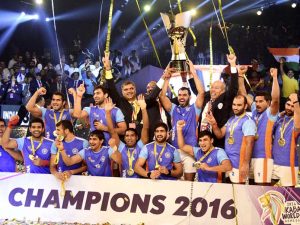 Pro Kabbadi’s viewership grew by 38% for all age groups in the urban market. The number of live games increased from 60 in 2014 and 2015 to 164 matches in 2016 which included the Kabaddi World Cup.
Pro Kabbadi’s viewership grew by 38% for all age groups in the urban market. The number of live games increased from 60 in 2014 and 2015 to 164 matches in 2016 which included the Kabaddi World Cup.
With the huge success of the PKL, the revival of the Kabaddi World Cup was the next step. India had won the Cup twice, but since 2007, there was no money to promote the sport. The 3rd World Cup was held in Ahmedabad in October 2016 with 12 countries participating in the tournament. After serving some fantastic sporting entertainment through 15 days, India and Iran met in the final battle. It was a tactical battle between two of the strongest teams in the competition that eventually became the most thrilling match of the tournament. Iran started better of the two as they led 18-13 at the interval. India came out fighting in the second half with some sensational raids. Iran crumbled towards the final moments and India closed out the match 38-29 to lift the trophy.
Thus, Kabaddi reignited childhood memory and an old passion for millions. For young India, it is a new sport that thrills them and gives them heroes to root for. The life of these heroes had completely taken a transformation. The Kabaddi players who hailed mainly from rural backgrounds were immensely talented but had a little earning. But PKL changed their future. Players were auctioned and bought. Most players to whom the returns were more to do with glory than money now have both glory and money.
Pro Kabaddi Season 5
The humble Kabaddi had a meteoric ascendance. The 5th season of PKL is back with 4 new teams-Gujarat Fortunegiants, Haryana Steelers, UP Yoddha and Tamil Thalaivas. This new edition has a new format in which 12 teams have been divided into two zones of six teams each. Zone A consists of Dabang Delhi, Jaipur Pink Panthers, Puneri Paltan, U Mumba, Haryana Steelers and Gujarat Fortunegiants while Zone B has Telugu Titans, Bengaluru Bulls, Patna Pirates, Bengal Warriors, UP Yoddha and Tamil Thalaivas. Each of the teams will play 15 intra-zone and seven inter-zone matches, prior to the play-offs. The play-offs stage will comprise three qualifiers and two eliminators, which are scheduled to take place in Mumbai and Chennai. The final will be held on 28th October in Chennai.
Bengaluru Bulls, Patna Pirates, Bengal Warriors, UP Yoddha and Tamil Thalaivas. Each of the teams will play 15 intra-zone and seven inter-zone matches, prior to the play-offs. The play-offs stage will comprise three qualifiers and two eliminators, which are scheduled to take place in Mumbai and Chennai. The final will be held on 28th October in Chennai.
The number of matches in this season has increased to more than 130 from 60 until the last season. This year there will be one season spread over a longer 13-week league, making it the longest duration Indian league sport. This edition is also having bigger prize money of 8 crore INR, a significant jump of 6 crore INR. The title winners will be awarded 3 crore INR while the runners-up will be given 1.8 crore INR and the team that finishing third will win 1.2 crore INR.
Its time again for putting on the lights, the buzzing of the spectators, chanting of the players’ name. Suddenly there’s absolute silence – only the muted sound of deep breathing. Then, just one word is spoken, over and over. Kabaddi. Kabaddi. Kabaddi. Kabaddi. Kabaddi. Kabaddi.

